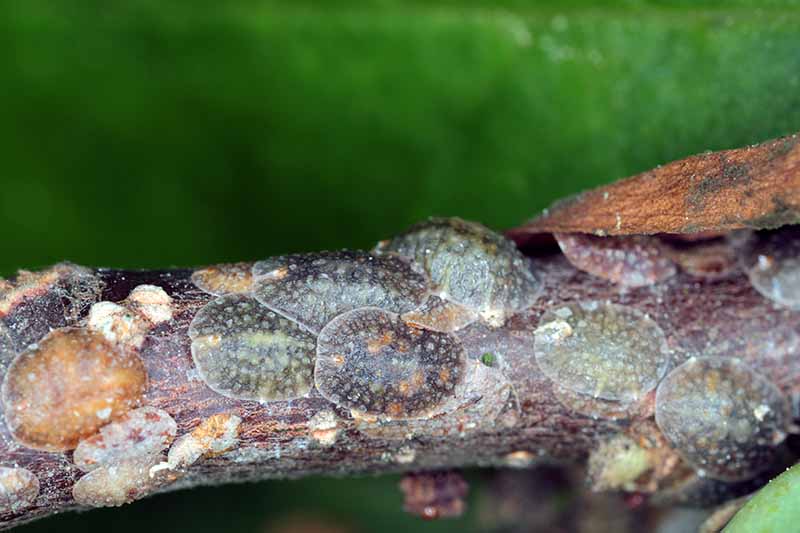The dramatic, sculptural flowers of bird of paradise plants are hard to miss. But look closely at the leaves and you may spot bumpy white or brown spots. These could be scale insects, a common pest of these tropical beauties.
While scale infestations rarely kill the plant, they can weaken and deform growth. Left unchecked, scales can spread rapidly making plants unsightly. The good news? With persistence and the right treatments scales can be controlled to restore the health and beauty of your bird of paradise.
Identifying Scale Insects on Bird of Paradise
Scales are small sap-sucking insects that attach themselves to stems leaves, and other plant parts to feed. There are two main types
-
Armored scale – Round flat bumps less than 1/8 inch wide. Often white tan, or brown. Have a waxy protective coating.
-
Soft scale – Larger, oval bumps up to 1/4 inch long. Smooth and soft-bodied. May secrete sticky honeydew that leads to black sooty mold growth.
Check the undersides of leaves and where leaves meet stems for telltale bumps. Use a magnifying glass to look closely. Scrape off a bump – live scales will be shallowly attached and easy to flick off.
Left uncontrolled, scales reproduce rapidly, spreading across leaves and stems. They insert piercing mouthparts into the plant to suck nutrients, causing yellow spots, deformed growth, leaf drop and sometimes dieback on heavily infested plants.
Why Bird of Paradise Get Scale
Bird of paradise plants are prone to scale for several reasons:
-
Originating in warm tropical regions, they lack cold tolerance and freeze damage stresses them.
-
Their large, soft leaves provide an ideal habitat for scales to colonize.
-
Their sap is rich in nutrients, which entices scales.
-
Slow growth in winter provides scales a chance to multiply.
-
Close plant spacing and warm conditions allow scales to migrate from plant to plant.
While bird of paradise plants are more susceptible than other plants, scales will infest many hosts. Prevent them from spreading by controlling populations.
Getting Rid of Scale on Bird of Paradise
Here are organic approaches to break the scale life cycle and control infestations on bird of paradise:
-
Prune out heavily infested leaves and stems – Remove the worst areas of infestation to eliminate large populations. Seal in a bag and dispose of.
-
Use horticultural oils – Light oils smother scales without harming plants. Coat all surfaces thoroughly. Repeat every 7-10 days for 2-3 applications.
-
Apply insecticidal soap spray – Spray plants, especially leaf undersides, every 5-7 days for several weeks. Kills juvenile scales.
-
Release ladybugs – Natural predators feed on scales. Buy and release near plants every 2-3 weeks during infestations.
-
Apply neem oil – Disrupts scale growth and reproduction. Coat plants every 7-10 days for a few weeks.
-
Keep plants vigorous – Healthy, vigorous growth fights scales. Fertilize and prune to promote new growth.
With persistence using multiple methods, scale populations can be substantially lowered. It takes diligence, but is worth the effort to protect beautiful bird of paradise plants. Don’t let scales detract from the stunning, sculptural blooms.
Preventing Scale on Bird of Paradise
Prevention is the best medicine when it comes to scales. Here are tips to help avoid infestations in the first place:
-
Select resistant cultivars like giant bird of paradise, which is less troubled by pests.
-
Check new plants carefully for signs of scales before purchase and planting.
-
Allow adequate spacing between plants to increase airflow.
-
Avoid excess fertilization which causes succulent, tender growth attractive to scales.
-
Monitor monthly and treat early before scales spread.
-
Remove chill-damaged foliage which stresses plants.
-
Control ants which interfere with natural predators.
-
Use row covers to exclude immigrating adult scales.
-
Turn potted plants frequently and inspect all sides.
While scales may occasionally find bird of paradise plants, staying vigilant helps avoid major headaches down the road. Pay attention and act quickly at first signs of scales before populations explode. A proactive, integrated approach keeps bird of paradise healthy and ever-blooming.

How to identify scale on houseplants
Scale insects are small, sticky bugs with hard shells that feed on plant nutrients (yeah, kinda gross). They show up on leaves and stems. This can cause your plants to lose color, vigor, and in extreme cases, death.
There are two types of scale—armored (hard scale) and unarmored (soft scale). The most common type of scale is hard brown bumps that look like armor on your plant’s leaves and stems. Scale can be any color, shape, or size. You may also see scale that is white and soft (or unarmored). Remember that once scales attach to a plant, you won’t be able to see it move. It can also be hard to get rid of scales completely when there are a lot of them.
Where does scale come from?
Your plant may get scale from many different places. It could be from another plant that is contaminated, farm-fresh food brought home from the market, or just being outside during the warmer months of the year. It’s not always clear where scale comes from, but also remember that plants that are sick or neglected are often more likely to get pests than plants that are healthy.
Scale & Mealybugs 101: Safeguarding Your Birds of Paradise
FAQ
How to get rid of scale on Birds of Paradise?
How do you get rid of scales on plants?
What does an unhealthy Bird of Paradise look like?
How do you treat fungus on birds of paradise?
- The Ultimate Guide to Growing Strawberries in Raised Beds - August 8, 2025
- No-Dig Garden Beds: The Easiest Way to Grow a Beautiful Garden - August 6, 2025
- How to Protect and Preserve Wood for Raised Garden Beds - August 6, 2025
